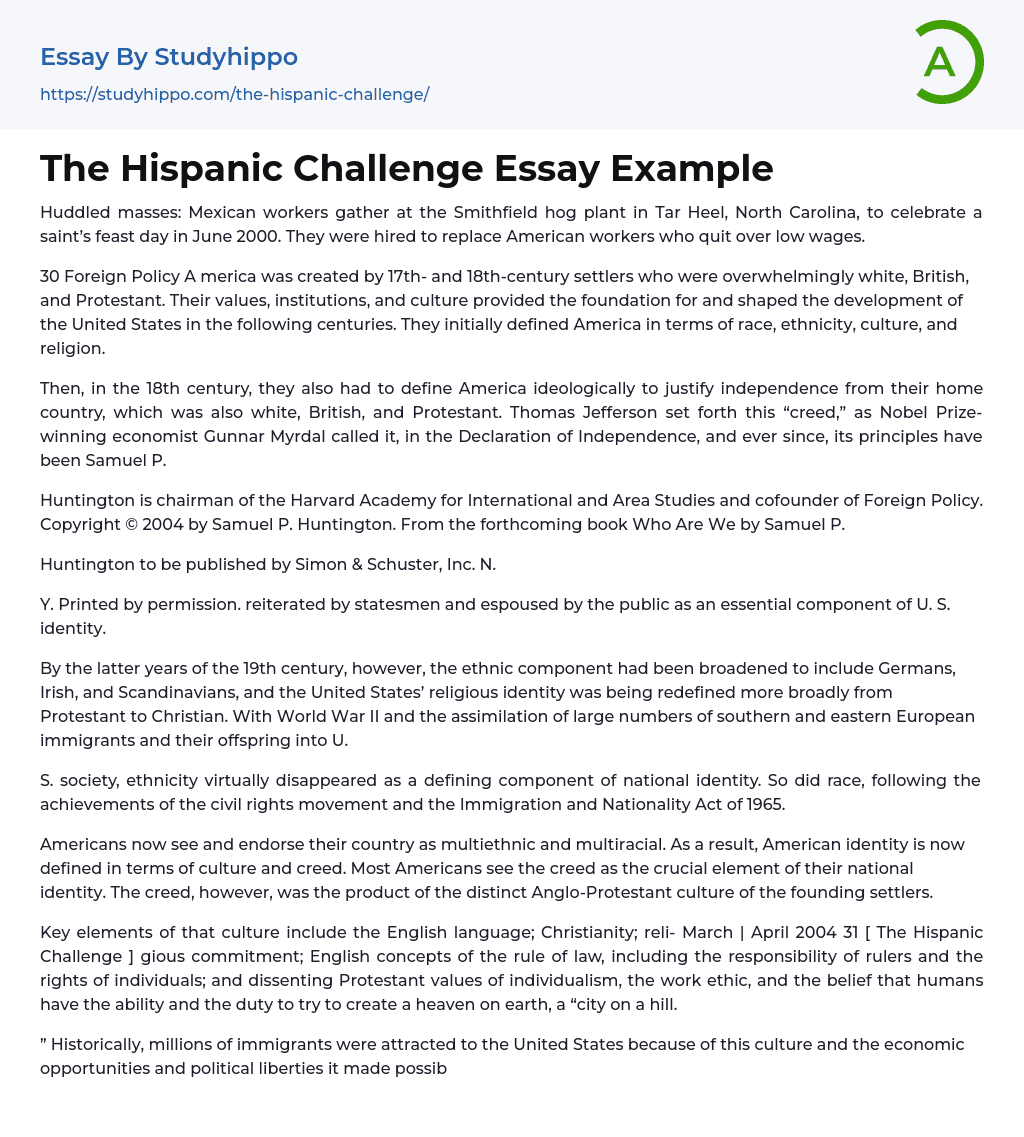Huddled masses: Mexican workers gather at the Smithfield hog plant in Tar Heel, North Carolina, to celebrate a saint’s feast day in June 2000. They were hired to replace American workers who quit over low wages.
30 Foreign Policy A merica was created by 17th- and 18th-century settlers who were overwhelmingly white, British, and Protestant. Their values, institutions, and culture provided the foundation for and shaped the development of the United States in the following centuries. They initially defined America in terms of race, ethnicity, culture, and religion.
Then, in the 18th century, they also had to define America ideologically to justify independence from their home country, which was also white, British, and Protestant. Thomas Jefferson set forth this “creed,” as Nobel Prize-winning economist Gunnar Myrdal called it, in the Declaration of Independence, and ever s
...ince, its principles have been Samuel P.
Huntington is chairman of the Harvard Academy for International and Area Studies and cofounder of Foreign Policy. Copyright © 2004 by Samuel P. Huntington. From the forthcoming book Who Are We by Samuel P.
Huntington to be published by Simon & Schuster, Inc. N.
Y. Printed by permission. reiterated by statesmen and espoused by the public as an essential component of U. S. identity.
By the latter years of the 19th century, however, the ethnic component had been broadened to include Germans, Irish, and Scandinavians, and the United States’ religious identity was being redefined more broadly from Protestant to Christian. With World War II and the assimilation of large numbers of southern and eastern European immigrants and their offspring into U.
S. society, ethnicity virtually disappeared as a defining component of nationa
identity. So did race, following the achievements of the civil rights movement and the Immigration and Nationality Act of 1965.
Americans now see and endorse their country as multiethnic and multiracial. As a result, American identity is now defined in terms of culture and creed. Most Americans see the creed as the crucial element of their national identity. The creed, however, was the product of the distinct Anglo-Protestant culture of the founding settlers.
Key elements of that culture include the English language; Christianity; reli- March | April 2004 31 [ The Hispanic Challenge ] gious commitment; English concepts of the rule of law, including the responsibility of rulers and the rights of individuals; and dissenting Protestant values of individualism, the work ethic, and the belief that humans have the ability and the duty to try to create a heaven on earth, a “city on a hill.
” Historically, millions of immigrants were attracted to the United States because of this culture and the economic opportunities and political liberties it made possible.
Contributions from immigrant cultures modified and enriched the Anglo-Protestant culture of the founding settlers. The essentials of that founding culture remained the bedrock of U. S. identity, however, at least until the last decades of the 20th century. Would the United States be the country that it has been and that it largely remains today if it had been settled in the 17th and 18th centuries not by British Protestants but by French, Spanish, or Portuguese Catholics? The answer is clearly no.
It would not be the United States; it would be Quebec, Mexico, or Brazil.
In the final decades of the 20th century,
however, the United States’ Anglo-Protestant culture and the creed that it produced came under assault by the popularity in intellectual and political circles of the doctrines of multiculturalism and diversity; the rise of group identities based on race, ethnicity, and gender over national identity; the impact of transnational cultural diasporas; the expanding number of immigrants with dual nationalities and dual loyalties; and the growing salience for U. S. intellectual, business, and political elites of cosmopolitan and transnational identities.
The United States’ national identity, to black and white American natives. Americans like to boast of their past success in assimilating millions of immigrants into their society, culture, and politics. But Americans have tended to generalize about immigrants without distinguishing among them and have focused on the economic costs and benefits of immigration, ignoring its social and cultural consequences. As a result, they have overlooked the unique characteristics and problems posed by contemporary Hispanic immigration.
The extent and nature of this immigration differ fundamentally from those of previous immigration, and the assimilation successes of the past are unlikely to be duplicated with the contemporary flood of immigrants from Latin America. This reality poses a fundamental question: Will the United States remain a country with a single national language and a core Anglo-Protestant culture? By ignoring this question, Americans acquiesce to their eventual transformation into two peoples with two cultures (Anglo and Hispanic) and two languages (English and Spanish).
- Ethnic Group essays
- Migration essays
- Human Migration essays
- Illegal Immigration essays
- Immigrants essays
- Refugee essays
- African American essays
- African American Culture essays
- American Values essays
- Asian American essays
- Chinese essays
- Ethnicity essays
- Ethnocentrism essays
- German essays
- Han Chinese essays
- Hispanic essays
- Identity essays
- Korean essays
- Mexican essays
- Nation essays
- Native American essays
- Race and Ethnicity essays
- White People essays
- Abortion essays
- Abuse essays
- Animal Rights essays
- Animal Testing essays
- Assault essays
- Bullying essays
- Controversial Issue essays
- Crash essays
- Cyber Bullying essays
- Feminism essays
- Human Rights essays
- Immigration essays
- Inequality essays
- Poverty essays
- Prejudice essays
- Racism essays
- Torture essays
- Violence essays
- Ageism essays
- Cultural Diversity essays
- Discrimination essays
- Diversity essays
- Gender Discrimination essays
- Multiculturalism essays
- Oppression essays
- Peer Pressure essays
- Racial Profiling essays




